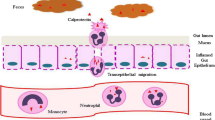Abstract
Inflammatory bowel disease (IBD), which includes ulcerative colitis, Crohn’s disease, and indeterminate colitis, is characterized by chronic inflammation of the digestive tract and has a significant impact on quality of life. Coupled with clinical history, physicians rely on invasive tests (e.g. endoscopy and radiologic examinations) to diagnose IBD. Patients with other gastrointestinal illnesses (e.g. irritable bowel syndrome and celiac disease) may present with symptoms similar to those of an IBD patient. Therefore, a need exists for rapid and noninvasive measures to indicate the presence of IBD. The identification of potential biomarkers associated with IBD has expanded rapidly in the past decade. This article reviews the role of recently studied serologic and fecal markers in the diagnosis of IBD, and differentiation between subtypes of IBD.
Similar content being viewed by others
References
Papers of particular interest, published recently, have been highlighted as: • Of importance
Papp M, Norman GL, Altorjay I, Lakatos PL: Utility of serological markers in inflammatory bowel diseases: gadget or magic? World J Gastroenterol 2007, 13:2028–2036.
Main J, McKenzie H, Yeaman GR, et al.: Antibody to Saccharomyces cerevisiae (baker’s yeast) in Crohn’s disease. BMJ 1988, 297:1105–1106.
Saxon A, Shanahan F, Landers C, et al.: A distinct subset of antineutrophil cytoplasmic antibodies is associated with inflammatory bowel disease. J Allergy Clin Immunol 1990, 86:202–210.
Cambridge G, Rampton DS, Stevens TR, et al.: Anti-neutrophil antibodies in inflammatory bowel disease: prevalence and diagnostic role. Gut 1992, 33:668–674.
Harrell L: Evolving serological markers for IBD. Inflamm Bowel Dis Monit 2007, 8:42–48.
Reese GE, Constantinides VA, Simillis C, et al.: Diagnostic precision of anti-Saccharomyces cerevisiae antibodies and perinuclear antineutrophil cytoplasmic antibodies in inflammatory bowel disease. Am J Gastroenterol 2006, 101:2410–2422.
Joossens S, Reinisch W, Vermeire S, et al.: The value of serologic markers in indeterminate colitis: a prospective follow-up study. Gastroenterology 2002, 122:1242–1247.
Melmed GY, Fleshner P, Bardakcioglu O, et al.: Family history and serology predict Crohn’s disease after ileal pouch-anal anastomosis for ulcerative colitis. Dis Colon Rectum 2008, 51:100–108.
Hui T, Landers C, Vasiliauskas E, et al.: Serologic responses in indeterminate colitis patients before ileal pouch-anal anastomosis may determine those at risk for continuous pouch inflammation. Dis Colon Rectum 2005, 48:1254–1262.
Dotan N, Altstock RT, Schwarz M, Dukler A: Anti-glycan antibodies as biomarkers for diagnosis and prognosis. Lupus 2006, 15:442–450.
Dotan I, Fishman S, Dgani Y, et al.: Antibodies against laminaribioside and chitobioside are novel serologic markers in Crohn’s disease. Gastroenterology 2006, 131:366–378.
• Ferrante M, Henckaerts L, Joossens M, et al.: New serological markers in inflammatory bowel disease are associated with complicated disease behaviour. Gut 2007, 56:1394–1403. This large study examined the association of the newer antiglycan markers and IBD, and was also the first to explore their relationship with complicated disease behavior.
Seow CH, Stempak JM, Xu W, et al.: Novel anti-glycan antibodies related to inflammatory bowel disease diagnosis and phenotype. Am J Gastroenterol 2009, 104:1426–1434.
Lodes MJ, Cong Y, Elson CO, et al.: Bacterial flagellin is a dominant antigen in Crohn disease. J Clin Invest 2004, 113:1296–1306.
Targan SR, Landers CJ, Yang H, et al.: Antibodies to CBir1 flagellin define a unique response that is associated independently with complicated Crohn’s disease. Gastroenterology 2005, 128:2020–2028.
Sutton CL, Kim J, Yamane A, et al.: Identification of a novel bacterial sequence associated with Crohn’s disease. Gastroenterology 2000, 119:23–31.
Iltanen S, Tervo L, Halttunen T, et al.: Elevated serum anti-I2 and anti-OmpW antibody levels in children with IBD. Inflamm Bowel Dis 2006, 12:389–394.
Cohavy O, Bruckner D, Gordon LK, et al.: Colonic bacteria express an ulcerative colitis pANCA-related protein epitope. Infect Immun 2000, 68:1542–1548.
Zholudev A, Zurakowski D, Young W, et al.: Serologic testing with ANCA, ASCA, and anti-OmpC in children and young adults with Crohn’s disease and ulcerative colitis: diagnostic value and correlation with disease phenotype. Am J Gastroenterol 2004, 99:2235–2241.
García Sánchez Mdel V, González R, Iglesias Flores E, et al.: Diagnostic value of fecal calprotectin in predicting an abnormal colonoscopy. Med Clin (Barc) 2006, 127:41–46.
Røseth AG, Kristinsson J, Fagerhol MK, et al.: Faecal calprotectin: a novel test for the diagnosis of colorectal cancer? Scand J Gastroenterol 1993, 28:1073–1076.
• Foell D, Wittkowski H, Roth J: Monitoring disease activity by stool analyses: from occult blood to molecular markers of intestinal inflammation and damage. Gut 2009, 58:859–868. This article is a nice review of fecal markers and their role in monitoring disease activity in patients with IBD. This paper also reviews the biology of biomarkers and discusses newer markers on the horizon.
Erbayrak M, Turkay C, Eraslan E, et al.: The role of fecal calprotectin in investigating inflammatory bowel diseases. Clinics (Sao Paulo) 2009, 64:421–425.
• Diamanti A, Panetta F, Basso MS, et al.: Diagnostic work-up of inflammatory bowel disease in children: the role of calprotectin assay. Inflamm Bowel Dis 2010 (Epub ahead of print). This prospective study examines the diagnostic accuracy of calprotectin in children with gastrointestinal symptoms suggestive of IBD.
Schoepfer AM, Beglinger C, Straumann A, et al.: Fecal calprotectin correlates more closely with the Simple Endoscopic Score for Crohn’s disease (SES-CD) than CRP, blood leukocytes, and the CDAI. Am J Gastroenterol 2010, 105:162–169.
Kane SV, Sandborn WJ, Rufo PA, et al.: Fecal lactoferrin is a sensitive and specific marker in identifying intestinal inflammation. Am J Gastroenterol 2003, 98:1309–1314.
Disclosure
Conflicts of interest: Dr. Harrell’s institution has received grants from Glycominds, Inc.; Dr. Beniwal—none.
Author information
Authors and Affiliations
Corresponding author
Rights and permissions
About this article
Cite this article
Beniwal, P., Harrell, L. The Status of Diagnostic Markers for Inflammatory Bowel Disease. Curr Gastroenterol Rep 12, 479–484 (2010). https://doi.org/10.1007/s11894-010-0145-9
Published:
Issue Date:
DOI: https://doi.org/10.1007/s11894-010-0145-9




